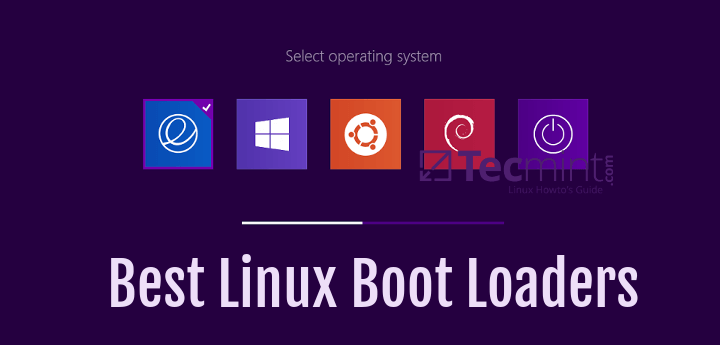
When you turn on your machine, immediately after POST (Power On Self Test) is completed successfully, the BIOS locates the configured bootable media, and reads some instructions from the master boot record (MBR) or GUID partition table which is the first 512 bytes of the bootable media.
The MBR contains two important sets of information, one is the boot loader and two, the partition table.
What is a Boot Loader?
A boot loader is a small program stored in the MBR or GUID partition table that helps to load an operating system into memory. Without a boot loader, your operating system can not be loaded into memory.
There are several boot loaders we can install together with Linux on our systems and in this article, we shall briefly talk about a handful of the best Linux boot loaders to work with.
1. GNU GRUB
GNU GRUB is a popular and probably the most used multiboot Linux boot loader available, based on the original GRUB (GRand Unified Bootloader) which was created by Eirch Stefan Broleyn. It comes with several improvements, new features, and bug fixes as enhancements to the original GRUB program.
Importantly, GRUB 2 has now replaced the GRUB. And notably, the name GRUB was renamed to GRUB Legacy and is not actively developed, however, it can be used for booting older systems since bug fixes are still ongoing.
GRUB has the following prominent features:
- Supports multi-boot
- Supports multiple hardware architectures and operating systems such as Linux and Windows
- Offers a Bash-like interactive command line interface for users to run GRUB commands as well interact with configuration files
- Enables access to the GRUB editor
- Supports setting of passwords with encryption for security
- Supports booting from a network combined with several other minor features
2. systemd-boot
systemd-boot is a UEFI boot loader developed as part of the systemd system and service manager, which was designed to load EFI-executable images, such as Linux kernels, initramfs images, and other operating systems, such as Windows.
systemd-boot is a relatively new bootloader, but it has become popular due to its simplicity and performance. It is also the default bootloader for many modern Linux distributions.
systemd-boot is a good choice for users who want a simple and fast bootloader that can boot a variety of operating systems. It is also a good choice for users who are already using systemd as their system and service manager.
3. rEFInd Boot Manager
rEFInd is a boot manager for UEFI and EFI-based systems that was created to boot a variety of operating systems, including Linux, Windows, and macOS.
rEFInd is a good choice for users who want a simple and user-friendly bootloader that can be customized to meet their needs. It is also a good choice for users who are dual-booting multiple operating systems.
4. LILO (Linux Loader)
LILO is a simple yet powerful and stable Linux boot loader. With the growing popularity and use of GRUB, which has come with numerous improvements and powerful features, LILO has become less popular among Linux users.
While it loads, the word “LILO” is displayed on the screen and each letter appears before or after a particular event has occurred. However, the development of LILO was stopped in December 2015, it has a number of features as listed below:
- It does not offer an interactive command-line interface
- Supports several error codes
- Offers no support for booting from a network
- All its files are stored in the first 1024 cylinders of a drive
- Faces limitations with BTFS, GPT, and RAID plus many more.
5. BURG – New Boot Loader
Based on GRUB, BURG is a relatively new Linux bootloader. Because it is derived from GRUB, it ships with some of the primary GRUB features, nonetheless, it also offers remarkable features such as a new object format to support multiple platforms including Linux, Windows, Mac OS, FreeBSD, and beyond.
Additionally, it supports a highly configurable text and graphical mode boot menu, and stream plus planned future improvements for it to work with various input/output devices.
6. Syslinux
Syslinux is an assortment of lightweight boot loaders that enable booting from CD-ROMs, from a network, and so on. It supports filesystems such as FAT for MS-DOS and ext2, ext3, and ext4 for Linux. It also supports uncompressed single-device Btrfs.
Note that Syslinux only accesses files in its own partition, therefore, it does not offer multi-filesystem boot capabilities.
Conclusion
A boot loader allows you to manage multiple operating systems on your machine and select which one to use at a particular time, without it, your machine can not load the kernel and the rest of the operating system files.
Have we missed any tip-top Linux bootloader here? If so, then let us know by using the comment form below to make suggestions of any commendable boot loaders that can support the Linux operating system.


